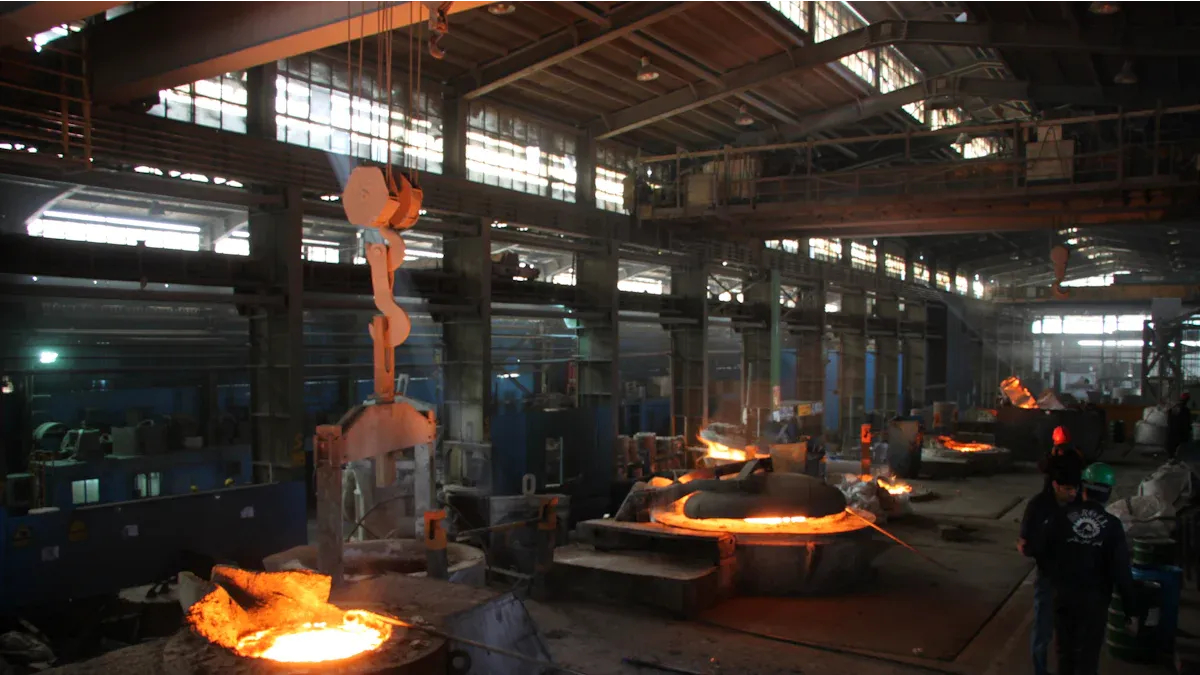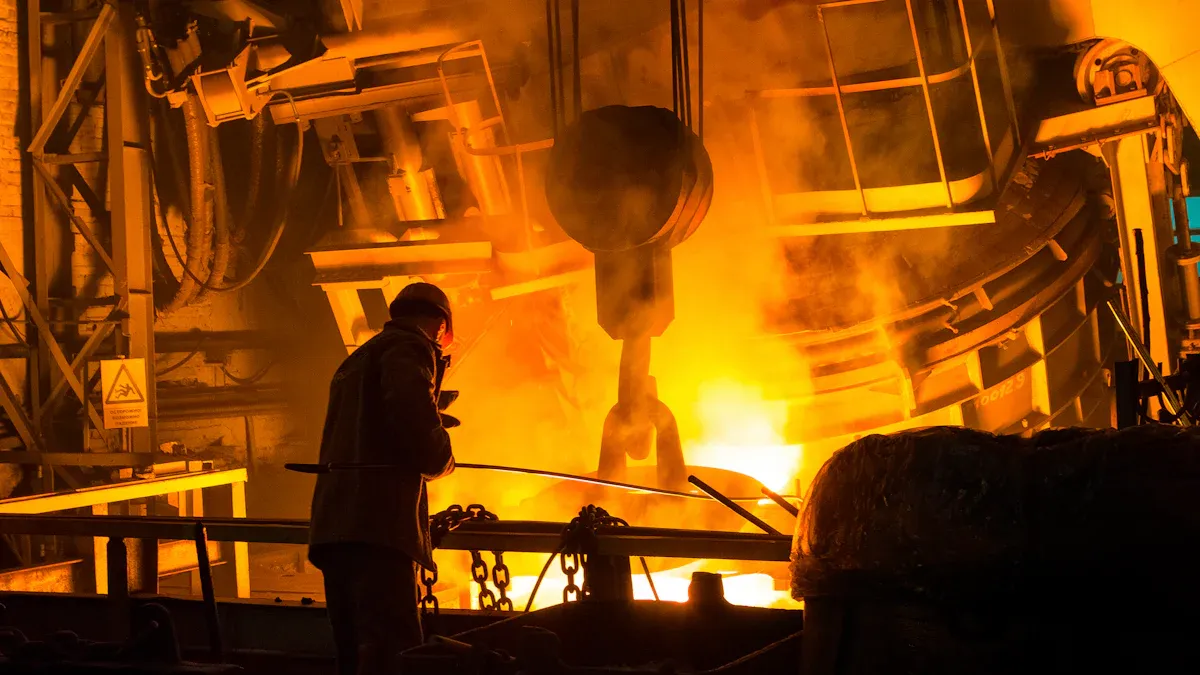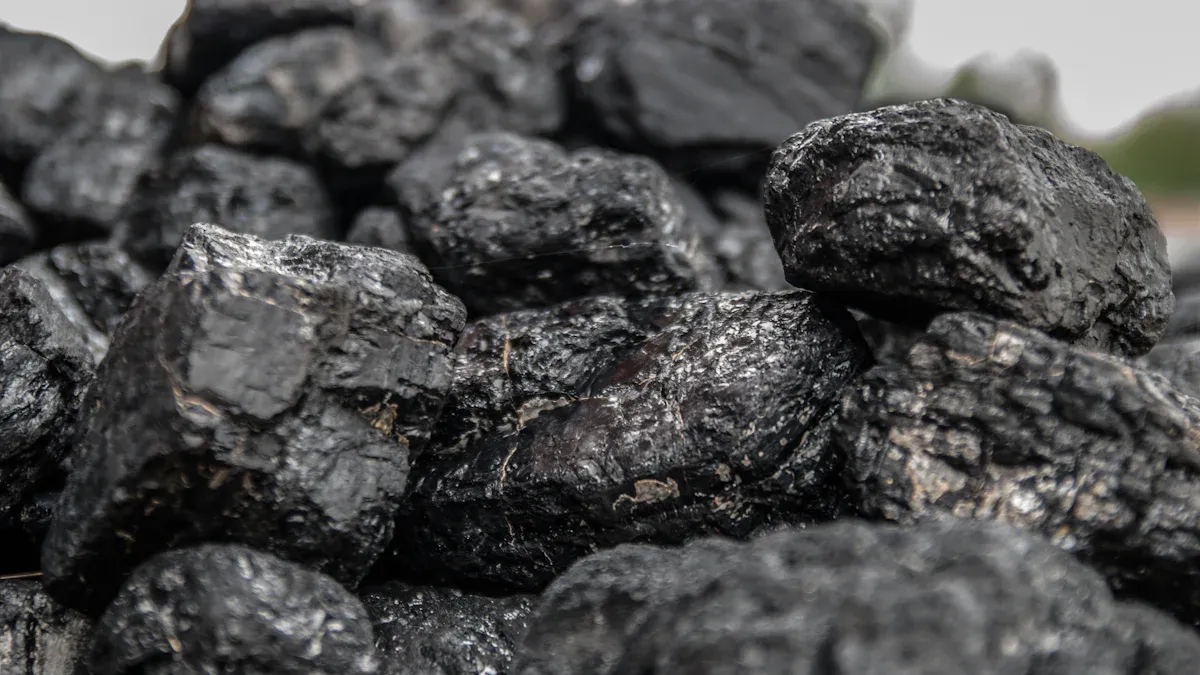
Coal mill resistant castings are specialized metal casting products designed to withstand the harsh conditions of coal mill operations. These castings play a vital role in industrial processes by resisting wear and tear caused by abrasion, heat, and impact. Foundries use advanced materials to create these components, ensuring they deliver exceptional durability and performance. Their primary purpose is to improve the efficiency of coal mills while reducing maintenance needs. By incorporating these resilient castings, industries can extend equipment lifespan and ensure reliable operations in demanding environments.

Coal mills operate in environments where abrasion and heat are constant challenges. As a result, the castings used in these mills must withstand extreme conditions. You might wonder how these castings achieve such resilience. The secret lies in their material composition and design. Foundries use advanced metal casting techniques to create components that resist wear caused by the grinding of coal particles.
Abrasion resistance is critical because coal mills handle abrasive materials daily. Without durable castings, the equipment would wear out quickly, leading to frequent replacements and costly downtime. High-chromium alloys, often used in casting production, provide exceptional wear resistance. These alloys form a protective layer on the surface, reducing the impact of abrasive forces.
Heat resistance is equally important. Coal mills generate significant heat during operation, which can weaken standard materials. Specialized castings maintain their structural integrity even at high temperatures. This ensures that the components perform reliably, even in the most demanding industrial settings.
Impact resistance is another vital feature of coal mill castings. During operation, coal mills experience heavy loads and sudden impacts. Without proper resistance, the components could crack or fail, disrupting the entire process. You can see the importance of impact resistance in maintaining smooth operations and avoiding costly interruptions.
For example, products like Devcon Wear Guard Fine Load have been applied to protect vertical coal mill components. These castings demonstrate exceptional resistance to both abrasion and high temperatures, withstanding up to 150°C (302°F) in dry environments. This level of durability reduces maintenance needs and increases overall productivity.
By investing in impact-resistant castings, you ensure that your coal mill operates efficiently under heavy loads. This not only extends the lifespan of the equipment but also minimizes operational downtime. The result is a more reliable and cost-effective industrial process.
High-chromium alloys are among the most effective materials used in casting production. These alloys are specifically designed to handle the extreme conditions coal mills face daily. You might wonder why high-chromium alloys are so effective. The answer lies in their unique composition and wear-resistant properties. These alloys typically contain 12% to 20% or more chromium, which significantly enhances their ability to resist abrasion and corrosion.
To better u nderstand their advantages, take a look at the comparison below:
| Property | High-Chromium Alloys | Other Materials |
|---|---|---|
| Chromium Content | 12% to 20%+ | Varies |
| Abrasion Resistance | Excellent | Moderate to Low |
| Resistance to Oxidizing Acids | High (especially HNO3) | Low to Moderate |
| Application Environments | Saline solutions, organic acids, marine atmospheres | Limited to specific conditions |
The high chromium content forms a protective layer on the surface of the alloy. This layer minimizes wear caused by abrasive coal particles. Addi tionally, these alloys perform exceptionally well in environments with oxidizing acids, such as nitric acid. This makes them ideal for coal mill castings, where both abrasion and chemical exposure are common challenges.
Studies also highlight the superior performance of high-chromium alloys. For instance, research on the "Wear and Corrosion Behavior of High-Cr White Cast Iron Alloys" emphasizes the role of eutectic carbides in enhancing wear resistance. These carbides act as a shield, protecting the material from damage during operation. Another study, "Effect of V-Ti on the Microstructure and Abrasive Wear Behavior of 6CrC Cast Steel Mill Balls," shows how alloying elements like vanadium and titanium further improve wear resistance.
By choosing high-chromium alloys for your cast iron products, you ensure long-lasting performance and reduced maintenance costs. These alloys not only withstand harsh conditions but also contribute to the overall efficiency of coal mill operations.
Corrosion-resistant stainless steel plays a crucial role in enhancing the durability of cast iron products. This material is specifically engineered to resist corrosion, which is a common issue in industrial environments. You might ask, "What makes this type of steel so effective?" The answer lies in its alloying elements, such a s chromium, nickel, and molybdenum. These elements create a passive layer on the surface, preventing corrosion from penetrating the material.
One key metric used to evaluate the performance of corrosion-resistant stainless steel is the Critical Pitting Temperature (CPT). This metric measures the material's resistance to pitting corrosion, which occurs in environments with high chloride content. Predictive models, developed using advanced techniques like machine learning, have furth er enhanced our understanding of how these materials perform under different conditions.
| Key Metric | Description |
|---|---|
| Critical Pitting Temperature (CPT) | A crucial metric for evaluating susceptibility to pitting corrosion in austenitic stainless steel. |
| Alloying Elements | Various elements affect the corrosion behavior, impacting the durability of castings. |
| Predictive Model | Developed using machine learning to enhance understanding and resistance to pitting corrosion. |
Corrosion-resistant stainless steel is particularly valuable in applications where exposure to moisture, chemicals, or extreme temperatures is unavoidable. For example, heat-resistant stainless steel variants can maintain their structural integrity even in high-temperature environments. This makes them an excellent choice for coal mill castings, where both heat and corrosion are signifi cant concerns.
By incorporating corrosion-resistant s tainless steel into your custom cast iron products, you can achieve high strength and long-term durability. This not only reduces the need for frequent replacements but also ensures reliable performance in demanding industrial settings.

Coal mill resistant castings play a critical role in power plants and cement manufacturing. These industries rely heavily on coal as a primary energy source or raw material. You might find it surprising that the power generation sector alon e consumes about 65% of global coal output. With over 2,400 operational coal plants worldwide, the demand for durable and efficient cast iron components is immense.
In power plants, castings ensure the smooth operation of coal mills by resisting wear and maintaining structural integrity. This is especially important in countries like China, which operates more than 1,000 coal plants and added 50 GW of new capacity in 2023. The durabilit y of these castings reduces maintenance needs, ensuring uninterrupted power generation.
Cement manufacturing also benefits significantly from these casting applications. Cement production consumes around 7% of global coal output, with rotary kilns requiring precise particle separation. Gray iron castings, known for their wear resistance, are essential in achieving this precision. Countries like Vietnam and Indonesia, which saw cement output growth of 12% and 8% respectively in 2023, rely on these products to meet increasing demand.
Beyond power plants and cement manufacturing, coal mill resistant castings find applications in various other industries. Steel manufacturing, for instance, has seen a 22% increase in the adoption of pulverized coal injection (PCI) technology since 2020. This process requires high-performance cast iron components to handle the a brasive nature of coal particles.
Gasification plants also depend on these casting applications. In China, gasification plants require coal particles to be ground to a fineness below 90 microns. Modern dynamic separators, made from gray iron and corrosion-resistant steel, achieve this level of precision.
Additionally, industries like mining and chemical processing benefit from the durability and wear resistance of these castings. Foundries design these products to withstand harsh environments, ensuring long-term reliability. By investing in high-quality cast iron and steel components, you can enhance operational e fficiency across a wide range of applications.
The casting process for coal mill components involves several precise steps to ensure the final products meet industrial standards. It begins with creating a mold, often made from sand or metal, shaped to match the desired component. Foundries then pour molten gray iron or steel into these molds. The molten material fills every cavity, forming the intr icate details required for coal mill operations.
Once the material cools and solidifies, the mold is removed, revealing the raw casting. This raw piece undergoes cleaning to remove any excess material or impurities. Afterward, machining refines the casting to meet exact specifications. This step ensures the components fit perfectly into coal mills, enhancing their durability and performanc e.
The choice of materials, such as gray iron or corrosion-resistant steel, plays a critical role in the process. Gray iron offers excellent wear resistance, while corrosion- resistant steel provides added protection against harsh environments. By combining these materials with advanced techniques, foundries produce cast iron components that withstand the demanding conditions of coal mills.
Quality control is essential in casting production. It ensures that every component meets the required standards for reliability a nd performance. Without stringent quality measures, defects could compromise the durability of cast iron products, leading to costly failures.
To maintain high standards, foundries use various quality control methods. These methods detect flaws, measure dimensions, and ensure the integrity of the castings. The table below highlights some common techniques:
| Quality Control Method | Purpose |
|---|---|
| Visual Inspection | Detects surface flaws, poor filling, and molding probl ems. |
| Dimensional Inspection | Ensures parts meet dimensional requirements to avoid costly post-production machining. |
| Dye Penetrant Testing | Identifies tiny surface cracks and pores that are hard to see. |
| Magnetic Particle Inspection | Detects small surface cracks in ferrous alloys quickly and inexpe nsively. |
| Ultrasonic Testing | Uses sound waves to detect internal defects and wall thickness. |
| Radiographic Inspection | Detects internal defects like shrinkage and inclusions, providing a perm anent record. |
| Eddy Current Inspection | Identifies small surface cracks in electrically conductive materials. |
| Pressure Leak Testing | Ensures castings are leak-proof. |
These methods ensure that gray iron and steel castings meet the highest standards. For example, ultrasonic testing detects internal defects that could weaken the casting. Radiographic inspection provides a detailed view of the internal structure, ensuring no hidden flaws exist.
By implementing these quality control measures, you can trust that the cast iron components will perform reliably in coal mills. This reduces the risk of downtime and extends the lifespan of your equipment. High-quality gray iron and steel products not only improve efficiency but also save costs in the long run.
Coal mill resistant castings offer significant cost savings by redu cing maintenance and operational downtime. When you use high-quality gray iron castings, you minimize wear and tear on critical components. This means fewer breakdowns and less time spent on repairs. For industries like power plants and cement manufacturing, where continuous operation is essential, this reliability is invaluable.
Gray iron castings excel in durability and resistance to corrosion. Their ability to withstand harsh conditions ensures that your equipment operates smoothly for longer periods. For example, components made from gray iron resist the abrasive forces of coal particles, reducing the need for frequent replacements. This durability translates into fewer interruptions and more consistent production.
Foundries also implement strict quality control measures to ensure the reliability of their products. Tech niques like ultrasonic testing and radiographic inspection detect flaws early, preventing potential failures. By investing in these high-quality castings, you can avoid costly downtime and maintain efficient operations.
Durable and efficient castings provide long-term economic benefits. When you choose gray iron products, you reduce the overall cost of ownership. These castings last longer, which me ans you spend less on replacements and repairs. Over time, this adds up to significant savings.
Corrosion-resistant materials, such as those used in gray iron castings, further enhance their value. By resisting corrosion, these components maintain their structural integrity even in challenging environments. This reduces the risk of unexpected failures and extends the lifespan of your equipment.
The efficiency of gray iron castings also contributes to cost savings. Their precise design and high-quality materials improve the performance of coal mills, leading to better energy utilization. This not only lowers o perational costs but also boosts productivity.
In addition, foundries produce these castings with sustainability in mind. By using advanced manufacturing techniques, they minimize waste and optimize resource use. This eco-friendly approach aligns with modern industry standards, making gray iron castings a smart investment for the future.
Coal mill resistant castings are essential for industries that demand durability and efficiency. These components improve equipment performance by resisting wear, heat, and impact. You benefit from reduced maintenance, fewer breakdowns, and lower operational costs. By choosing high-quality castings, you ensure long-term reliability and enhanced productivity. This investment not only saves money but also supports smoother industrial processes.
Remember, durable castings are the backbone of efficient coal mill operations. They help you achieve consistent results while minimizing downtime.
Gray iron offers excellent wear resistance and durability. Its unique microstructure helps it withstand the abrasive forces in coal mills. This makes it a reliable choice for casting components that need to endure harsh industrial conditions.
Quality control ensures that every casting meets strict standards. Techniques like ultrasonic testing and radiographic inspection detect flaws early. This guarantees that the final product per forms reliably in demanding environments, reducing the risk of failures.
Yes, gray iron castings can withstand high temperatures. Their composition allows them to maintain structural integrity even in extreme heat. This mak es them ideal for coal mills, where heat resistance is crucial for long-term performance.
Corrosion resistance prevents materials from degrading in harsh environments. For coal mills, this ensures that components last longer and require less maintenance. Corrosion-resistant materials like gray iron enhance the overall quality and d urability of castings.
Durable castings minimize wear and tear, reducing the need for frequent replacements. This lowers maintenance costs and prevents downtime. By investing in high-quality gray iron components, you ensure efficient and cost-effective operations.